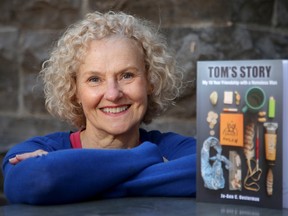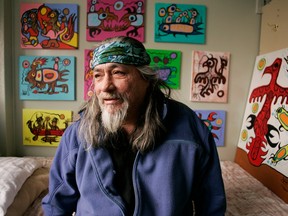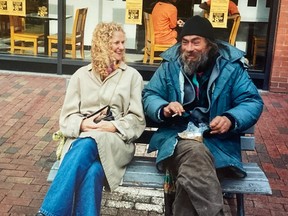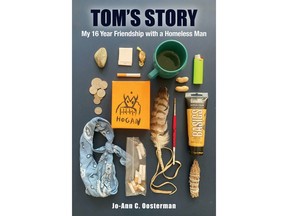Tom Hogan wanted an exhibition of his work at the Canadian Museum of Civilization. That never happened. But nine years after the Ojibwa artist’s death, his story gets told.
Article content
I first met Tom Hogan 20 years ago, on Christmas Day. He was bundled up in three coats and a tuque, and huddled against an exterior wall of the Canadian Museum of Nature, trying not to freeze to death. He was 47 years old, and looked every day of it and then some. He didn’t want to live in a shelter, he told me. “I’ve only got a few years left,” he said. “I’d like to have my own place.
Advertisement 2
Article content
“If I keel over, I keel over,” he added. “I don’t want to die on the street.”
I could only try to imagine some of the things I later learned about Hogan’s life — the abuse by his foster parents, for example, his alcoholism and homelessness. But his fear of dying a cold death on the street was something I easily related to. It has long been how I similarly don’t want to die.
He told me, too, that he was an artist, that he hoped to have an exhibition of his work at the Canadian Museum of Civilization, and that he and a friend of his were working on a book about his life and art. I didn’t know if what he said was true. I had no real reason to disbelieve him, except, well, my own bias in what I saw — there he was, huddled up against the world, his snot freezing in his rough beard and asking me if I had a match so he could light the cigarette butt he’d picked up off the sidewalk.
Article content
Advertisement 3
Article content
Of course, I discovered, it was all true.
An Ojibwa artist, Hogan did eventually have exhibitions of his Woodlands-style paintings, albeit not at the museum. And his life didn’t end on the street; towards the end, he was living at The Oaks, on Merivale Road, a Shepherds of Good Hope residence with a managed-alcohol harm-reduction program. He died in The Ottawa Mission’s hospice in 2014.
And nine years after his death, the book, Tom’s Story: My 16 Year Friendship with a Homeless Man, is finally out.

It’s the work of Jo-Ann Oosterman, an Ottawa woman who first met Hogan in 1998 when she was an outreach worker and volunteered to help set up an art program for marginalized people. Hogan was among its first participants, often selling his work on the streets for the price of a drink, or less.
Advertisement 4
Article content
“For Tom and for the people who came to the art group, working on their art seemed to be a healing and validating process,” Oosterman recalled. “The burden of poverty, addictions, mental illness, trauma, etc., did not define them while they created. They were artists.”
Oosterman knew Hogan’s paintings were good, and recognized parallels between his and Indigenous artist Norval Morrisseau’s paths that went beyond their similar styles.
“I knew that Norval Morrisseau was taken advantage of many, many times. People would give him the money to buy another bottle, and they would take his paintings,” she said. “And I saw Tom selling his paintings for the price of a bottle of sherry, and I just thought, ‘This is crazy.’”
Advertisement 5
Article content

She offered to store his artwork for him at her home, which eventually led to her organizing his exhibitions. From that initial act of kindness grew a friendship that, like so many relationships, was at once loving, caring, carefree, difficult and frustrating.
A friend of Oosterman’s, meanwhile, suggested she keep a journal of her experiences with Hogan, without which Oosterman says the book would likely never have been written. When Oosterman broached the idea with Hogan, he asked if she meant a biography, and then immediately launched into the details of his early life.
“And then many times after that, when we would spend time together, he would tell me some fantastic stories, and then he would say, ‘Just make sure you put it in the book.’”
Advertisement 6
Article content

The book, available at local indie booksellers, almost didn’t happen. Oosterman sent it to five publishers, three of which sent back “really nice” rejection letters. She heard only crickets from the other two. So last spring, on the eve of its deadline, she entered her manuscript in an annual competition held by Nova Scotia publisher Pottersfield Press.
“I was sitting in front of my computer at 10 o’clock at night,” she recalled, “and the deadline was midnight. I just wanted to go to bed and I thought ‘I’m not going to win this. But if I don’t submit, I’m going to feel really shitty.’”
About two weeks later, she learned she’d won.
Through Oosterman’s interaction with Hogan, the book captures Hogan’s humour, his gruffness, his kindness and his hardships. There are little offbeat stories, like the time he worked in a carnival, or when he rode a moose in the woods. There are other stories, such as Hogan sharing his thoughts on his abusive adopted father, that show his outsized heart. There are stories of psychotic episodes and drunken binges, sad examples of a man living a life that too often barely reached the level of subsistence.
Combined, the stories humanize Tom Hogan in ways we should all remember. He, like others on the street, deserved much better than he got.
“How can we expect someone to ‘get it together’ if they don’t even have their own four walls, a toilet and a bed to crawl into?” Oosterman asks. “Tom was interesting and challenging and gracious, and he was homeless.
“If someone reads my book and then they feel more compassion for marginalized people, great. That is a step in the right direction.”




Comments
Postmedia is committed to maintaining a lively but civil forum for discussion and encourage all readers to share their views on our articles. Comments may take up to an hour for moderation before appearing on the site. We ask you to keep your comments relevant and respectful. We have enabled email notifications—you will now receive an email if you receive a reply to your comment, there is an update to a comment thread you follow or if a user you follow comments. Visit our Community Guidelines for more information and details on how to adjust your email settings.
Join the Conversation